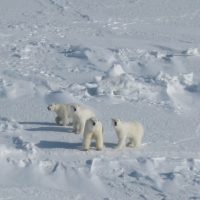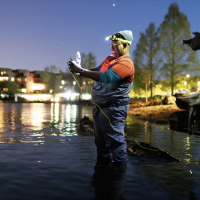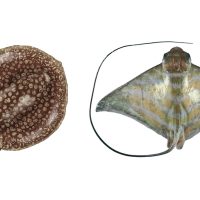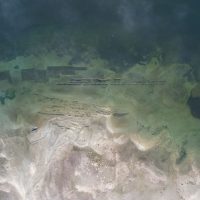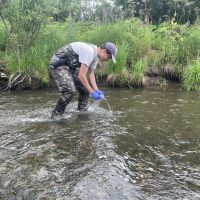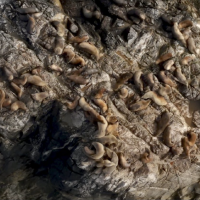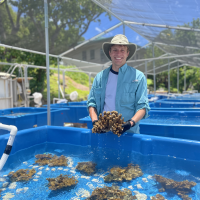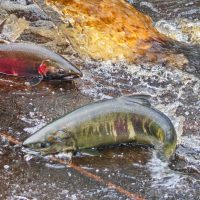Filter Results
A sweet surprise: Polar bear glucose reveals new insights into their reproduction and conservation
Each year, polar bears cycle through periods of intense feasting and prolonged fasting. For reproductive females, seasonal bulking is crucial – it fuels the winter denning and fasting period when they give birth. And when they emerge in spring, it gives biologists a chance to assess populations. A new study led by Sarah Teman explores whether A1c could reveal if a polar bear had recently denned, which – combined with the absence of cubs – may signal reproductive failure.
Read moreSeattle Times story features Ashley Townes’ work counting Chinook salmon in Lake Washington
Wearing a bright orange and gray dry suit, Ashley Townes stepped into the murky water of Lake Washington under a yellow moon, at a time when most others are asleep. A recent Seattle Times story features Ashley’s work as a fish biologist and a member of a grassroots group of neighbors who have advocated and fundraised for years to restore Be’er Sheva Park, to restore the shoreline and salmon habitat.
Read moreForce, form, and function: New method explains stingray skeleton architecture
A UW mechanical engineering student’s research is revealing how generative design can be used to analyze the complex shapes found in biological rigid structures like skeletons. John Michael Racy, along with co-authors including Adam Summers, turned to generative design to understand the complex forces that shape the elements of the stingray fin skeleton.
Read moreChanging waters, changing views: Stakeholder perspectives on ocean acidification and adaptations in shellfish aquaculture
Shellfish aquaculture is a vital industry in the US, but one which faces mounting challenges threatening both productivity and business viability. Research often fails to align with growers’ immediate needs, so to close this gap, a team led by Connor Lewis-Smith set out to document how industry participants perceive ocean acidification threats and evaluate emerging adaptation strategies that are actively being researched.
Read moreCoursework, capstone, and connections: The multi-dimensional nature of the SAFS undergraduate degree
For many students about to embark on their undergraduate journey at university, they plan to study one thing but end up studying something completely different. This was the case for SAFS undergraduate, Ryan Luvera. Ryan is currently undertaking his capstone research project, focusing on improving salmon abundance estimation models using eDNA.
Read moreDrones and machine learning help swimmers stay safe from sharks
Funded by the California Ocean Protection Council, SAFS Professor, Corey Garza, and colleagues at Stanford, UC Santa Cruz and the Middlebury Institute have embarked on a project to better understand shark and pinniped behavior off the California coast. They do this by tagging and tracking the animals, collecting background environmental data through buoys and mapping where pinnipeds gather. The goal is to understand how these variables interact and better predict when and where white sharks might be on the prowl — and, importantly, how to keep people out of the water when they are.
Read moreCorals, contaminants, and climate change
Bleaching. This complicated and foreboding term now lurks around every conversation about coral reefs. Impacted heavily by climate change and associated warming oceans, coral reefs experience bleaching when the algae that live in their tissues and contribute vitally to their growth are expelled, causing the corals to lose their color, and possibly their lives. Callum Backstrom, SAFS PhD student and one of UW’s 2025 Husky 100, is studying the resilience of certain corals to bleaching.
Read moreParasite video featuring Chelsea Wood, nominated for an Emmy
The 2024 Northwest Emmy Nominees Environment/Science includes a video featuring SAFS Professor, Chelsea Wood, and her work on parasites. The video, produced by Grist, explores why nature can’t run without parasites, and what happens when they start to disappear.
Read moreBringing to life the story of Pacific salmon and their recovery challenges
In a StoryMap bringing to life the challenges faced by Pacific salmon, SAFS graduate student, Amirah Casey, dives into the role of urban stormwater runoff and climate change in hindering salmon recovery.
Read moreNew molecular tools for reef conservation and climate resilience
New research led by UW Medicine, and involving Jacqueline Padilla-Gamiño from SAFS, has revealed that certain protein particles distinguish resilient corals from those that succumb to bleaching, offering new molecular tools for reef conservation and climate resilience.
Read more